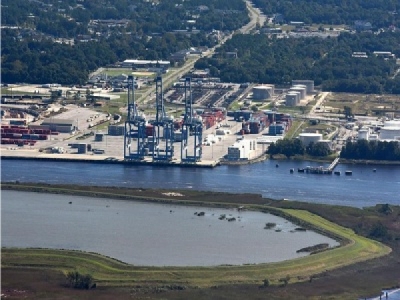
Posted on May 18, 2017
By Adam Wagner, StarNews Online
When the U.S. Army Corps of Engineers dredges the Port of Wilmington’s shipping channel, it has to put the spoil somewhere.
Traditionally, that has meant piling it onto three cells on Eagles Island’s southern end. By next summer, one of those will stand at 40 feet and the other two will be 42 feet.
Still, according to a corps environmental assessment, that will only be sufficient to hold the fill until about 2024, and the corps is exploring raising the dikes to 50 feet apiece by gradually increasing them beginning in 2019.
In the environmental assessment, the corps wrote that adding feet to the dikes would not impact water quality, marine life, cultural resources or other aspects of the environment — even as it aids the local economy by allowing ships to access the port.
What’s happening?
The Army Corps of Engineers is preparing plans to raise a trio of dikes containing dredge spoil from the Wilmington Harbor navigation project to 50 feet apiece. The project is not, according to a corps environmental impact study, severely impact the environment or the view shed, while helping keep the Port of Wilmington viable in an age of ever-larger ships.
The project is thus far unfunded, as there are ongoing projects to raise one of the dikes to 40 feet and the other two to 42 feet. Completing the environmental impact statement allows the project to move forward quickly once funds are allocated.
How many dikes are there? Three
How tall are they? By 2018, one will be 40 feet and two others will be 42 feet
How many homes’ views could be affected? 15
“Eagles Island has been, and will continue to be, the most cost-effective method of disposal for dredge material when performing maintenance dredging in the Wilmington Harbor navigation channel,” Lisa Parker, a corps spokeswoman, wrote in an email. “Therefore, it is crucial to increase Eagles Island’s capacity for future disposal material.”
The increase to 50-feet apiece remains unfunded for now, Parker added, but completing the environmental assessment means the corps will be able to begin future work once funds are allocated.
View impacts
Raising the dikes would, according to the environmental review, block about 15 homeowners on the Brunswick River looking east from seeing the port and nearby industrial sites. Still, according to the review, much of that view is already hindered by the existing dikes.
Michael Mallin, a research professor in the University of North Carolina Wilmington’s biology department, said adding to the dikes likely wouldn’t pose an environmental problem unless there was a breach at one of the sites. In that event, sediments that may have been locked underground containing heavy metals or compounds could be transferred to the water and aquatic life.
“It all depends on the containment structure,” said Mallin, who is the science director for the Lower Cape Fear River Program, which monitors water quality.
In November 2009, a then-35-foot dike on the southern tip of the island breached, burying an estimated 5 acres of wetlands. Corps officials at the time said heavy rainfall from the remnants of Tropical Storm Ida, which drenched Southeastern North Carolina, likely played a role in the berm collapse.
“Least-cost option”
Among the other alternatives the corps considered was taking the dredged material to its site in the Atlantic off the mouth of the Cape Fear River between 2024 and 2032. That would have led to an estimated cost of $14.28 million a year, compared to an average annual cost of $8.04 million for raising the dikes and constructing necessary toe berms.
“Increasing the dredged material capacity of cells 1, 2 and 3 will provide a feasible disposal site for Wilmington Harbor maintenance dredging for the next 16 years,” the corps wrote. “It is important to continue using (Eagles) Island as a disposal facility for as long as possible, as its access and proximity make it the least-cost option.”
Allowing the cells to reach capacity, the corps added, would mean dredged material would have to be sailed to the offshore fill location. That could result in higher costs, according to the corps, potentially resulting in less frequent dredging and affecting ships’ ability to impact the port.
Ultimately, the corps concluded that adding to the dikes would not lead to any “significant” impacts on the environment.
Still, the corps will be back in the same position as 2032 nears — searching for a place to put yet more dredge spoil from the Cape Fear River.
“It’s a subject,” Mallin said, “that right now there’s no good answers to.”
Source: StarNews Online





